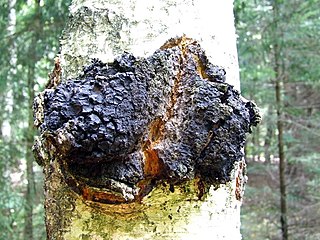Related Research Articles

Acidobacteriota is a phylum of Gram-negative bacteria. Its members are physiologically diverse and ubiquitous, especially in soils, but are under-represented in culture.

Lyngbya is a genus of cyanobacteria, unicellular autotrophs that form the basis of the oceanic food chain.
Thermithiobacillus is a genus of nonsporeforming, rod-shaped, Gram-negative bacteria. The name derives from the Latin thermae, for warm baths, and the Classical Greek θείος, theios for sulfur. The type species of this genus was previously assigned to the genus Thiobacillus, but it was reclassified on the basis of 16S rRNA analysis in 2000, creating this genus.

The Hymenochaetales are an order of fungi in the class Agaricomycetes. The order in its current sense is based on molecular research and not on any unifying morphological characteristics. According to one 2008 estimate, the Hymenochaetales contain around 600 species worldwide, mostly corticioid fungi and poroid fungi, but also including several clavarioid fungi and agarics. Species of economic importance include wood decay fungi in the genera Phellinus and Inonotus sensu lato, some of which may cause losses in forestry. Therapeutic properties are claimed for Inonotus obliquus ("chaga") and Phellinus linteus, both of which are now commercially marketed.

The Polyporaceae are a family of poroid fungi belonging to the Basidiomycota. The flesh of their fruit bodies varies from soft to very tough. Most members of this family have their hymenium in vertical pores on the underside of the caps, but some of them have gills or gill-like structures. Many species are brackets, but others have a definite stipe – for example, Polyporus badius.
Mycobacterium kubicae is a Gram-positive, nonmotile and acid-fast bacterial species. Cells are typically rod-shaped, with some coccoid forms. Colonies of M. kubicae on solid media are generally smooth and domed, with a yellow scotochromogenic pigment. On Löwenstein-Jensen media they appear film-like. This species is not known to be pathogenic to humans. The species is named after American mycobacteriologist George Kubica.

Inonotus obliquus, commonly called chaga, is a fungus in the family Hymenochaetaceae. It is parasitic on birch and other trees. The sterile conk is irregularly formed and resembles burnt charcoal. It is not the fruiting body of the fungus, but a sclerotium or mass of mycelium, mostly black because of a great amount of melanin. Some people consider chaga medicinal.

Meshimakobu and sanghuang / sanghwang, also known as mesima (English) or black hoof mushroom, is a mushroom in East Asia.

The Hymenochaetaceae are a family of fungi in the order Hymenochaetales. The family contains several species that are implicated in many diseases of broad-leaved and coniferous trees, causing heart rot, canker and root diseases, and also esca disease of grapevines. According to a standard reference text, the family contains 27 genera and 487 species.

Inonotus is a genus of fungi in the family Hymenochaetaceae. The genus, described by Petter Karsten in 1879, is estimated to contain about 80 species sensu lato and 30 species sensu stricto.
Tannerella forsythia is an anaerobic, Gram-negative bacterial species of the Bacteroidota phylum. It has been implicated in periodontal diseases and is a member of the red complex of periodontal pathogens. T. forsythia was previously named Bacteroides forsythus and Tannerella forsythensis.
Alkalihalobacillus alcalophilus is a Gram-positive, rod-shaped species of bacteria. Likely strains of this species have been isolated from highly alkaline waste water. A. alcalophilus is a moderate halotolerant obligate alkaliphile growing at 40 °C and at pH 9–10.5 that has been isolated from soil and animal manures.
The Selenomonadales are an order of bacteria within the class Negativicutes; unlike most other members of Bacillota, they are Gram-negative. The phylogeny of this order was initially determined by 16S rRNA comparisons. More recently, molecular markers in the form of conserved signature indels (CSIs) have been found specific for all Selenomonadales species. On the basis of these markers, the Selenomonadales are inclusive of two distinct families, and are no longer the sole order within the Negativicutes. Several CSIs have also been found specific for both families, Sporomusaceae and Selenomonadceae. Samples of bacterial strains within this order have been isolated from the root canals of healthy human teeth.

Lyngbya majuscula is a species of filamentous cyanobacteria in the genus Lyngbya. It is named after the Dane Hans Christian Lyngbye.

Phellopilus is a fungal genus in the family Hymenochaetaceae. Circumscribed in 2001, the genus is monotypic, containing the single widespread species Phellopilus nigrolimitatus.
Rothia kristinae is a Gram positive bacterium. R. kristinae is a common human skin organism, but can cause opportunistic infections in humans.
Bacillus fumarioli is a species of aerobic endospore-forming bacteria. It is moderately thermophilic and acidophilic, with type strain LMG 17489T.
Magnetococcus marinus is a species of Alphaproteobacteria that has the peculiar ability to form a structure called a magnetosome, a membrane-encased, single-magnetic-domain mineral crystal formed by biomineralisation, which allows the cells to orient along the Earth’s geomagnetic field. The Magnetococcus marinus grows chemolithoautotrophically with thiosulfate and chemoorganoheterotrophically on acetate.
Tropicoporus tropicalis is a mushroom of the family Hymenochaetaceae. Tropicoporus tropicalis is a wood-decaying basidiomycetes that rarely causes disease in animals and human, and is commonly found in humid climate such as Brazil. In its natural environment, the fungus is associated with white rot woody angiosperms, and has its annual fruiting body on tree trunks and branches. Tropicoporus tropicalis has two kinds of hyphae, generative and skeletal, that lack clamp connections.
Tropicoporus linteus is a tropical American mushroom. Its former name Phellinus linteus is applied wider, including to an East Asian mushroom.
References
- ↑ Zhou L-W; Vlasák J; Decock C; Assefa A; Stenlid J; Abate D; Wu S-H; Dai Y-C. (26 April 2015). "Global diversity and taxonomy of the Inonotus linteus complex (Hymenochaetales, Basidiomycota): Sanghuangporus gen. nov., Tropicoporus excentrodendri and T. guanacastensis gen. et spp. nov., and 17 new combinations". Fungal Diversity. 77: 335–347. doi:10.1007/s13225-015-0335-8. S2CID 16031605.